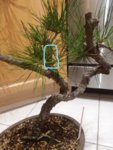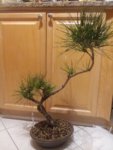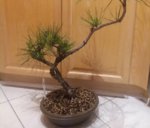Lochamp
Seedling
Hi everyone,
I picked this healthy looking JBP up at my club’s recent auction for a good price. I have some thoughts on where to take this, but would be happy to hear the community’s thoughts as I’m fairly new to pines.
I picked this healthy looking JBP up at my club’s recent auction for a good price. I have some thoughts on where to take this, but would be happy to hear the community’s thoughts as I’m fairly new to pines.
- Looks like it was decandled in the summer. Later in the fall I will reduce the secondary candles to 2 and reduce needles. My gut tells me to keep letting the leader grow and chop it off at the highlighted orange area in a few years. Any thoughts?
- The way the sacrificial branch crosses over the other one is a bit odd to me. Coupled with that fact that there is no branching on the bottom is a bit concerning. Any suggestions here?
- The highlighted blue area is inversely tapered relative to the branch (guessing because the first branch is close to the base of the other branch). Should this be kept? I think so as without it there would be a big gap in between branches
- The yellow highlighted area has a bit of wire on it already to pull the branches down, and I’m thinking to continue this down over the next few years to create the lowest branching area of the tree














